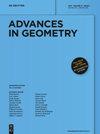广义线星在PG(3, l)上的正则平行:有向情况
IF 0.5
4区 数学
Q3 MATHEMATICS
引用次数: 0
摘要
利用Klein对应关系,ℝ) Betten和Riesinger用一个称为超群判定(hfd)线集的对偶对象来描述。在这个集合的跨度为3的特殊情况下,第二次对偶会产生一个更方便的对象,称为广义线星。这两种结构后来都被作者简化了。在这里,我们改进了我们的简化方法,以便对有向线的正则平行性获得类似的结果。因此,我们可以证明,对于我们所称的有向平行主义,与无向平行主义相比,有更多的可能性。证明需要对投影空间(如流形和格)、投影平面,特别是平移平面中的方向进行彻底的分析。这是为了根据PG(3,ℝ). 事实证明,这是相当微妙的。即使是面向并行性建模的对偶对象的合适类的定义也不那么明显。本文章由计算机程序翻译,如有差异,请以英文原文为准。
Regular parallelisms on PG(3,ℝ) from generalized line stars: the oriented case
Abstract Using the Klein correspondence, regular parallelisms of PG(3, ℝ) have been described by Betten and Riesinger in terms of a dual object, called a hyperflock determining (hfd) line set. In the special case where this set has a span of dimension 3, a second dualization leads to a more convenient object, called a generalized star of lines. Both constructions have later been simplified by the author. Here we refine our simplified approach in order to obtain similar results for regular parallelisms of oriented lines. As a consequence, we can demonstrate that for oriented parallelisms, as we call them, there are distinctly more possibilities than in the non-oriented case. The proofs require a thorough analysis of orientation in projective spaces (as manifolds and as lattices) and in projective planes and, in particular, in translation planes. This is used in order to handle continuous families of oriented regular spreads in terms of the Klein model of PG(3, ℝ). This turns out to be quite subtle. Even the definition of suitable classes of dual objects modeling oriented parallelisms is not so obvious.
求助全文
通过发布文献求助,成功后即可免费获取论文全文。
去求助
来源期刊

Advances in Geometry
数学-数学
CiteScore
1.00
自引率
0.00%
发文量
31
审稿时长
>12 weeks
期刊介绍:
Advances in Geometry is a mathematical journal for the publication of original research articles of excellent quality in the area of geometry. Geometry is a field of long standing-tradition and eminent importance. The study of space and spatial patterns is a major mathematical activity; geometric ideas and geometric language permeate all of mathematics.
 求助内容:
求助内容: 应助结果提醒方式:
应助结果提醒方式:


